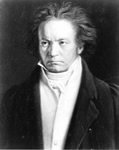Ludwig van Beethoven
(late Classic/early Romantic-Germany)

Born:
1770 (baptized December 17), Bonn, Germany
Died: March 26, 1827, Vienna, Austria
In his
own words . . .
"I
carry my thoughts about with me for a long time . . . before writing them down
. . . once I have grasped a theme. I shall not forget it even years later. I
change many things, discard others, and try again and again until I am
satisfied; then, in my head . . . [the work] rises, it grows, I hear and see
the image in front of me from every angle . . . and only the labor of writing
it down remains. . . . I turn my ideas into tones that
resound, roar, and rage until at last they stand before me in the form of
notes."
German
composer. Often considered a transitional figure from the Classic to the
Romantic era.
Ludwig van Beethoven is often described by musicians as a "giant straddling two styles": the Classical and
the Romantic. Indeed, it is a testimony to Beethoven's place in history that he
is claimed for both periods. Whether Beethoven was a Classical or a Romantic
composer, however, is beside the point. Instead, we might best view him as a
new composer for a new age—an age that is reflected in musical, as well
as nonmusical, worlds.
Haydn
and Mozart lived during a time of nascent ideals of liberty and two major
revolutions. They also lived in a world of royal patronage, in which Haydn
flourished but Mozart floundered. In contrast, Beethoven came of age as an
artist when the consequences of revolutions had to be confronted and when the
burden of patronage had already shifted to the less reliable mechanisms of the
commercial sphere: publication and concert proceeds, supplemented by sporadic
noble patronage. It was a far more disorderly world for Beethoven, yet one full
of exciting potential.
It is in
this world of change that we find Beethoven to be one of the most enigmatic
composers. By the middle of his life he was almost totally deaf and had yet to
produce his most profound works. In many ways cut off from the world, Beethoven
was still committed to the idea of "brotherhood" so powerfully
expressed in his Ninth Symphony. These tensions and contradictions find a voice
in many of his compositions. His symphonies, starting with the Third (the Eroica), are huge works, as are some of his late
quartets. Yet at the same time, he could compress his works. These sometimes contradictory aspects are part of Beethoven's
character and part of the times in which he lived. And they make Beethoven one
of the most interesting of all the great composers.
Works
Summary
Orchestral
music, including 9 symphonies (No. 1, 1800; No. 2, 1802; No. 3, Eroica, 1803; No. 4, 1806; No. 5, 1808; No.
6, Pastoral, 1808; No. 7, 1812; No. 8, 1812; No. 9, Choral,
1824), overtures (Leonore, Nos. 1,
2, and 3 and Egmont), and incidental music
Concertos,
including 5 for piano, 1 for violin (1806), and 1 triple concerto (piano,
violin, and cello, 1804)
Chamber
music, including string quartets, piano trios, quartets, 1 quintet, 1 septet,
violin and cello sonatas, serenades, and wind chamber music
32
piano sonatas, including Op. 13 (Pathetique,
1806), Op. 27, No. 2 (Moonlight, 1801), Op. 53 (Waldstein, 1804), and Op. 57 (Appassionata, 1805)
An
opera, Fidelio (1805)
Choral
music, including Missa solemnis
(1823)
Songs,
including a song cycle, An die ferne Geliebte (To the Distant Beloved, 1816)
Works to
be Featured on the WMU Dalton Wednesday Series
Piano Trio in C minor, Op. 1 No. 3
.